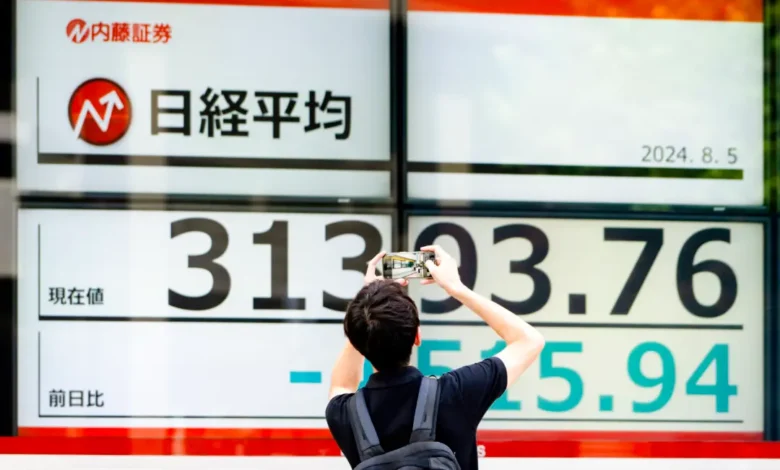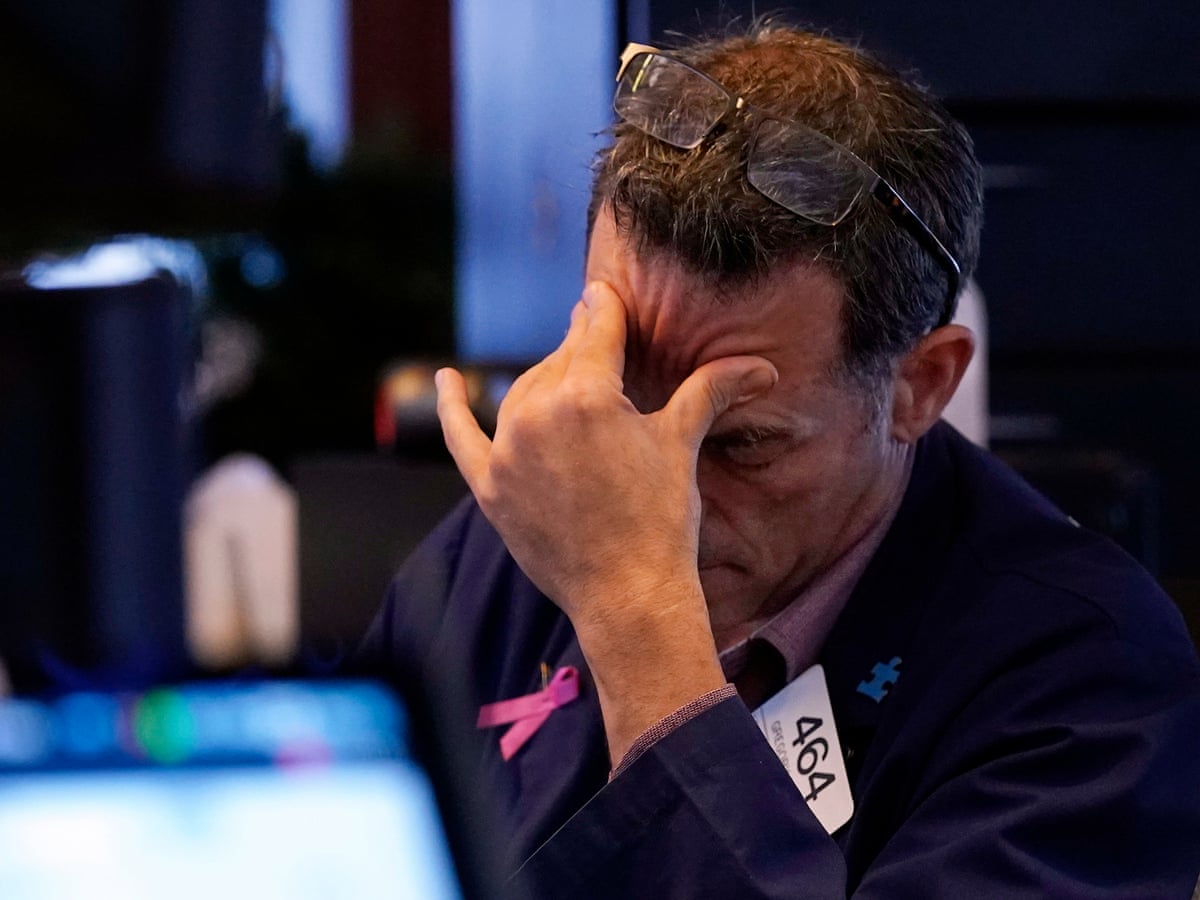The Global Meltdown, Markets Feel The Bear As Japanese Market Collapse Killing Yen-Carry Trade; Is US To Be Blamed For The Current Meltdown In The Markets Globally; What Are The Headwinds For Investors?
On Monday, August 5, 2024, global financial markets experienced significant turmoil, marked by a historic drop in Japan's Nikkei 225 Index and widespread sell-offs across various stock exchanges. The Japanese market upheaval has sparked concerns among investors and traders about the potential onset of a prolonged bear market. Meanwhile, the US Nasdaq was also down, indicating that all is not well with the US markets and economy. Back home, Indian stock markets fell sharply on Monday due to weak US jobs data and growing signs of conflict between Iran and Israel in the Middle East.

Monday saw a bloodbath in the global markets as the Nikkei 225 Index fell by 12.4% in a single day, which is its biggest drop since 1995. Major Japanese companies like Mitsubishi, Mitsui, and Sumitomo, saw their stock prices drop by more than 10%.
So what happened?
The yen got stronger, and this caused problems in global markets as the yen-dollar trade started to unwind.
In June 2023, the Japanese market was one of the best-performing markets in the world, with a 31% return; this was also when the stock market guru Warren Buffett was heavily investing in Japanese stocks.
Investors thought the 35-year bear market in Japan was finally over, but it seems they were mistaken.
Meanwhile, the US Nasdaq also saw a sharp drop, and there is news that Buffett has reduced his investment in Apple by 50%; thus suggesting things are not going well in the US markets and economy.
Traders and investors are worried that the current downturn might last a long time fearing that the recent bull run in global markets might turn into a bear market.
However, some believe that US interest rates will come down, leading to a market correction rather than a big fall. This is also true for India’s Nifty 50, where domestic institutions are providing support.
Last week’s panic selling in global stocks and the sharp rise in the Japanese yen created a risky situation, causing a big drop in bond yields. The question is whether this drop indicates a long-term shift from stocks to bonds or if it was just a temporary panic.
There are also concerns that the yen-carry trade, which has been happening for years, could finally unwind, leading to a global margin call and the start of a bear market for stocks.
The Nasdaq is down 10% for the month, and stocks like Nvidia and Apple are at their yearly lows.

India’s Bloodbath
The global stock sell-off worsened on Monday, with India’s Nifty 50 dropping by 2.7%, following the slump in Asian markets.
Indian stock markets fell sharply on Monday due to weak US jobs data and growing signs of conflict between Iran and Israel in the Middle East.
The BSE Sensex dropped by 2,686 points (3.3%) to a low of 78,296 during the day, and the NSE Nifty50 fell below 24,000 to a low of 23,894, down 824 points (3.3%).
By the end of the day, the Sensex was down 2,223 points (2.74%) at 78,768.42, and the Nifty50 was down 662 points (2.68%) at 24,055.
So what really is going on with the Yen and why is it concerning?
On July 11, the yen appreciated sharply after former US President Donald Trump said that China and Japan were keeping their currencies weak, hurting US manufacturers.
Since then, the yen has continued to rise, further boosted by the Bank of Japan’s July 31 decision to raise its short-term interest rate to around 0.25% from around 0 to 0.1%.
Now, for a country that had negative rates for years, this was a big change; the increase in Japanese rates comes as the US Federal Reserve is about to start cutting its rates.
Thus, the combination of Trump’s comments and the rate hike worried investors.
Since July 11, Japan’s main stock index, the Nikkei 225, has dropped over 25%, while the yen has gone up over 12%.
The unwinding of short positions on the yen at the end of July also added to its rise. Some yen appreciation is helpful for Japan because it imports a lot of oil, and a stronger yen reduces their oil import costs and domestic inflation.

What’s All This Talk of Carry Trade Unwind, and Can It Crush Equities?
Until last year, Japan was the only country with negative interest rates in a world of rising rates. Investors borrowed money in Japan at near-zero rates to invest in high-yield assets abroad like US dollars, emerging market currencies, and equities.
This carry trade market is estimated to be over USD 4 trillion; however, as inflation and growth increased in Japan, along with rising stock prices, the Bank of Japan had to abandon negative rates.
Now, higher rates and yen appreciation are leading to the unwinding of this yen-carry trade.
A carry trade that made sense at zero rates may not be viable when rates are positive and the host currency is rising; the unwinding of leveraged trades can be problematic for financial markets, making equities and other assets vulnerable.
However, it hasn’t reached a level that could cause a financial catastrophe. With a short-term adjustment to higher rates in Japan, markets are expected to stabilize due to the still significant, though narrowing, interest rate differential between the US and Japan.
Has the Interest Rate Gap Between the US and Japan Narrowed?
At the start of 2020, before the US began its rate-hike cycle, the difference between the US 10-year and Japanese 10-year bond yields was around 60 basis points, with US bonds yielding more.
This was because Japan had a negative interest-rate policy. After the US started raising rates in 2022, the gap widened to 417 basis points in 2023.
Now, with the US preparing to cut rates and Japan raising theirs, the gap has narrowed to about 285 basis points. The US 10-year bond yield is currently 3.79%, while Japan’s is 0.96%.
Recently, overseas investors benefited from the yen’s depreciation and the large rate differential. Now, the reverse is happening: the rate differential is narrowing, and the yen is appreciating, creating challenges for yen-carry traders.
This has caused fear and panic in the markets because the size of this unwinding could impact global fund flows.

Are the US Recession Fears Coming True?
Last week, US stock markets fell sharply on fears of a slowdown as the unemployment rate rose to 4.3%, the highest in nearly three years, raising concerns that the US economy is slowing faster than expected and that the Federal Reserve has been slow to cut interest rates.
Goldman Sachs increased the probability of a US recession in the next year to 25% from 15%. However, it’s important to note that the US GDP grew by 2.8% in the April-June quarter of 2024-25.
The CBOE Volatility Index (VIX) exceeded its long-term average of 20 points, reaching 29.66 intraday on Friday before closing at 23.39, its highest level since March 2023.
The Nasdaq has fallen 10% from its recent all-time high since July 10. Intel shares had their worst performance in 50 years on Friday, dropping 26% to $21.48.
The 10-year Treasury yield fell 18 basis points to 3.79%, and the dollar index decreased by 0.7%. Lower yields were accompanied by a falling dollar index. It’s observed that the US Fed often follows the bond market’s signals, so the market is indicating a need for significant interest rate cuts going forward.

Has the Broader Equity Market Trend Changed?
While short-term risks have increased, the recent decline appears to be a result of a few days of panic selling rather than a shift in the overall trend.
Fundamentally, there are only fears of a future American recession, but the current data indicates steady economic activity.
Lower interest rates and a weak dollar should ideally support a continuation of bullish markets rather than a move towards bearish markets.
Among the US equity indices, the Dow Jones Industrial Average and the S&P 500 are maintaining their 20-week moving averages.
Japan’s Nikkei 225 is trading at its 50-month moving average, a level from which it has bounced in the past.
Technical analysis suggests that both the Nikkei 225 and the USD-Yen are oversold and could be poised for a rebound.
India’s Nifty-50, the strongest among the indices, is holding support at its 40-day moving average.
Even though Japan’s interest rate has increased to a quarter of a percentage point, it is still significantly below US rates.
Therefore, the anticipated equity market crash and a global unwind of the yen-carry trade, if it occurs, may be a concern for the future rather than an immediate threat.
Is the US to Blame for the Current Meltdown in Global Markets?
Analysts suggest that the recent meltdown in global equity markets reflects a wind-down of carry trades used by investors rather than a fundamental shift in the US economic outlook.
Friday’s weaker-than-expected US jobs data triggered the market sell-off, with Japan’s Nikkei index experiencing its biggest one-day drop since the 1987 Black Monday selloff. However, the employment report alone wasn’t weak enough to cause such drastic moves.
The real cause seems to be a sharp unwinding of carry trades. Investors have borrowed money from low-interest-rate economies like Japan or Switzerland to invest in higher-yielding assets elsewhere. They were caught off guard as the Japanese yen rallied over 11% against the dollar from 38-year lows reached just a month ago.
Mark Dowding, chief investment officer at BlueBay Asset Management, noted that much of the market sell-off is due to position capitulation. Many macro funds were caught on the wrong side of the trade, triggering pre-determined levels for buying or selling, initially starting with foreign exchange and the Japanese yen.
While exact numbers and specific positioning shifts are hard to pinpoint, analysts believe that crowded positions in US tech stocks, funded by carry trades, explain why these stocks are suffering the most.
Carry trades, fueled by years of ultra-easy Japanese monetary policy, led to a boom in cross-border yen borrowing to fund trades elsewhere. ING noted that cross-border yen borrowing has increased by $742 billion since the end of 2021, according to data from the Bank for International Settlements.
Tim Graf, head of macro strategy for Europe at State Street Global Markets, explained, “It’s a yen-funded carry unwind and Japanese stock unwind. Our positioning metrics show investors were overweight Japanese stocks and underweight yen. They’re no longer underweight yen.”
Speculators have aggressively cut bearish bets against the yen in recent weeks, reducing the net short position in the yen to $6.01 billion, its smallest since January, down from April’s seven-year high of $14.526 billion, according to recent weekly data from the US markets regulator.
Hedge Fund Pain
Hedge funds typically fund their bets through borrowing, and their adjustments are exacerbating market moves, according to some investors. Banks provide hedge funds with leverage, essentially a loan to fund investing, which amplifies returns but also increases losses.
Goldman Sachs sent a note to clients on Friday indicating that gross leverage from Goldman Sachs prime brokerage, the total amount that hedge funds have borrowed, declined in June and July but remains near five-year highs.
Last week marked the third consecutive week that hedge funds’ bets on falling stocks outpaced bets on rising stocks, Goldman said in a separate note. For every long position added, there were 3.3 short bets.
As of Monday, Japan-focused hedge funds were down 7.6% over the past three trading sessions.
While macro funds may have been involved in currency trades relating to the yen, many stock-trading hedge funds shifted their focus to Japan due to a short selling ban in South Korea and regulatory challenges in China, investors said.
Analysts suggest there could be further short-term pain as positions are unwound, but the market shake-up is expected to be limited.
Traders now anticipate over 120 basis points of US rate cuts by the end of the year, compared to around 50 basis points at the start of last week, and fully price in a hefty 50 basis point rate cut in September.
Such expectations may be overdone if upcoming data suggests the US economy is likely to avoid a hard landing.
The Last Bit, Recent market turmoil has been driven by a combination of factors, including a sharp appreciation of the yen, changes in interest rate policies, and the unwinding of carry trades.
While short-term risks and volatility have increased, this appears to be more of a reaction to sudden market shifts and panic selling rather than a fundamental change in the broader equity market trend.
The interest rate differential between the US and Japan has narrowed, impacting carry trades that have been in place for years leading to significant market moves, especially in US tech stocks and Japanese equities.
Despite fears of a global market crash, the overall economic data points to steady activity, and lower rates combined with a weak dollar could support a continuation of bullish markets.
Hedge funds, which rely heavily on leverage, have amplified market movements as they adjust their positions. With regulatory challenges in some Asian markets, many have focused on Japan, exacerbating the recent sell-off.
However, analysts believe that while there may be more short-term pain, the broader market shake-up will likely be limited.
Expectations of significant US rate cuts may be premature if upcoming data suggests the economy is avoiding a hard landing.
In the end, while there are concerns and increased volatility, the fundamentals do not yet indicate a major shift towards a prolonged bear market.




